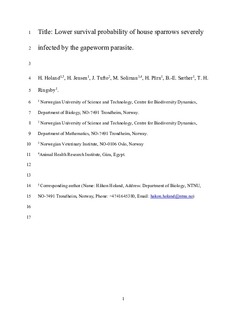| dc.contributor.author | Holand, Håkon | |
| dc.contributor.author | Jensen, Henrik | |
| dc.contributor.author | Tufto, Jarle | |
| dc.contributor.author | Soliman, Mustafa M. | |
| dc.contributor.author | Pärn, Henrik | |
| dc.contributor.author | Sæther, Bernt-Erik | |
| dc.contributor.author | Ringsby, Thor Harald | |
| dc.date.accessioned | 2017-10-30T12:50:48Z | |
| dc.date.available | 2017-10-30T12:50:48Z | |
| dc.date.created | 2014-04-25T20:40:51Z | |
| dc.date.issued | 2014 | |
| dc.identifier.citation | Journal of Avian Biology. 2014, 45 (4), 365-373. | nb_NO |
| dc.identifier.issn | 0908-8857 | |
| dc.identifier.uri | http://hdl.handle.net/11250/2462893 | |
| dc.description.abstract | The effect of parasites in natural populations has received increasing attention in recent years. Studies have shown that parasites may play an important part in population ecology due to their potential effects on host fitness. The main purpose of the present study was to investigate the effect of a nematode parasite (gapeworm, Syngamus trachea) on survival probability of house sparrows Passer domesticus from six natural populations located on 4 islands in the Helgeland archipelago in northern Norway. Infection status was obtained from feces samples collected from 603 house sparrows in the summer and autumn of 2007–2011. We also collected data on a visible symptom of severe infection (gasping for air) in 1391 house sparrows in the summer and autumn 2004–2011. We took advantage of recent advances in disease modeling in a multi-event capture–mark–recapture framework to account for imperfect observations (state uncertainty). Each dataset was separately analyzed, in both analyses we investigated the relationships of year, island, individual body condition, age class and population density with survival probabilities. The relationship between infection (determined by feces egg counts) on annual survival of house sparrows was not statistically significant. However, the probability of annual survival was found to be significantly lower for adult house sparrows exhibiting a symptom of severe gapeworm infection, gasping for air. The present study demonstrates that severe infection by a parasite can have a negative relationship with survival probability of short-lived avian hosts in wild populations. | nb_NO |
| dc.language.iso | eng | nb_NO |
| dc.publisher | Wiley | nb_NO |
| dc.subject | Dyr | nb_NO |
| dc.subject | Animal | nb_NO |
| dc.title | Lower survival probability of house sparrows severely infected by the gapeworm parasite | nb_NO |
| dc.type | Journal article | nb_NO |
| dc.type | Peer reviewed | nb_NO |
| dc.description.version | acceptedVersion | nb_NO |
| dc.source.pagenumber | 365-373 | nb_NO |
| dc.source.volume | 45 | nb_NO |
| dc.source.journal | Journal of Avian Biology | nb_NO |
| dc.source.issue | 4 | nb_NO |
| dc.identifier.doi | 10.1111/jav.00354 | |
| dc.identifier.cristin | 1129988 | |
| dc.relation.project | Norges forskningsråd: 221956 | nb_NO |
| dc.relation.project | Norges forskningsråd: 223257 | nb_NO |
| dc.description.localcode | This is the peer reviewed version of the following article: [Lower survival probability of house sparrows severely infected by the gapeworm parasite], which has been published in final form at [http://onlinelibrary.wiley.com/doi/10.1111/jav.00354/abstract]. This article may be used for non-commercial purposes in accordance with Wiley Terms and Conditions for Self-Archiving. | nb_NO |
| cristin.unitcode | 194,66,10,0 | |
| cristin.unitcode | 194,63,15,0 | |
| cristin.unitname | Institutt for biologi | |
| cristin.unitname | Institutt for matematiske fag | |
| cristin.ispublished | true | |
| cristin.fulltext | postprint | |
| cristin.qualitycode | 1 | |
